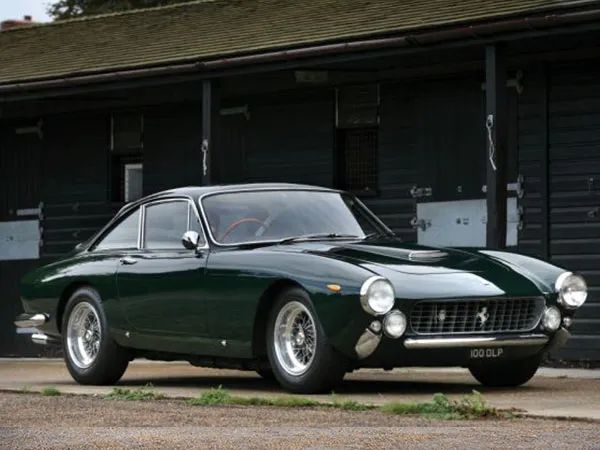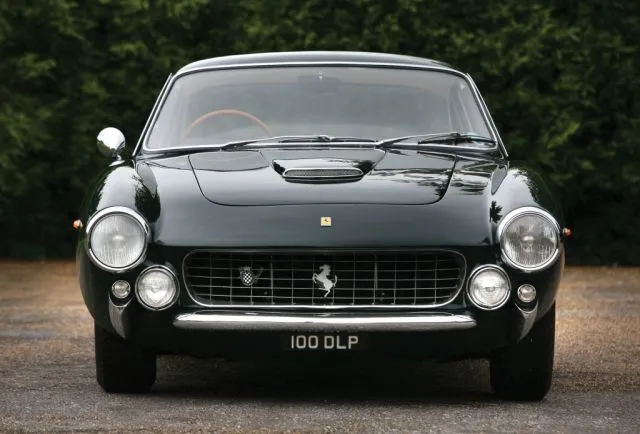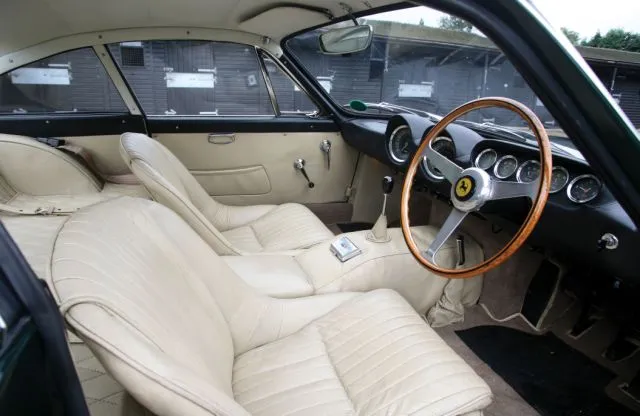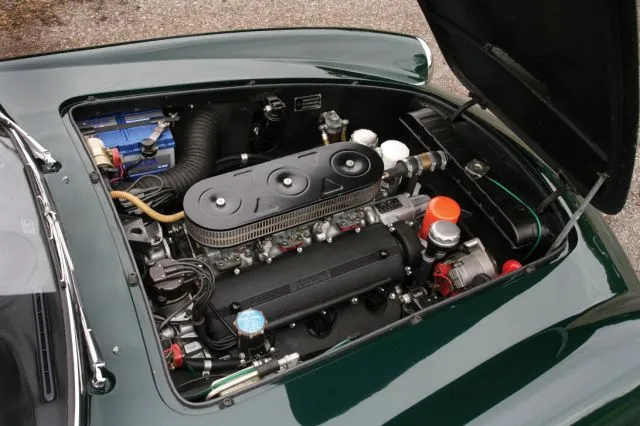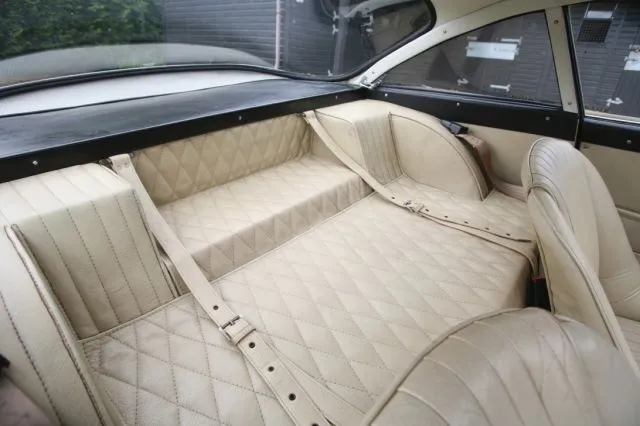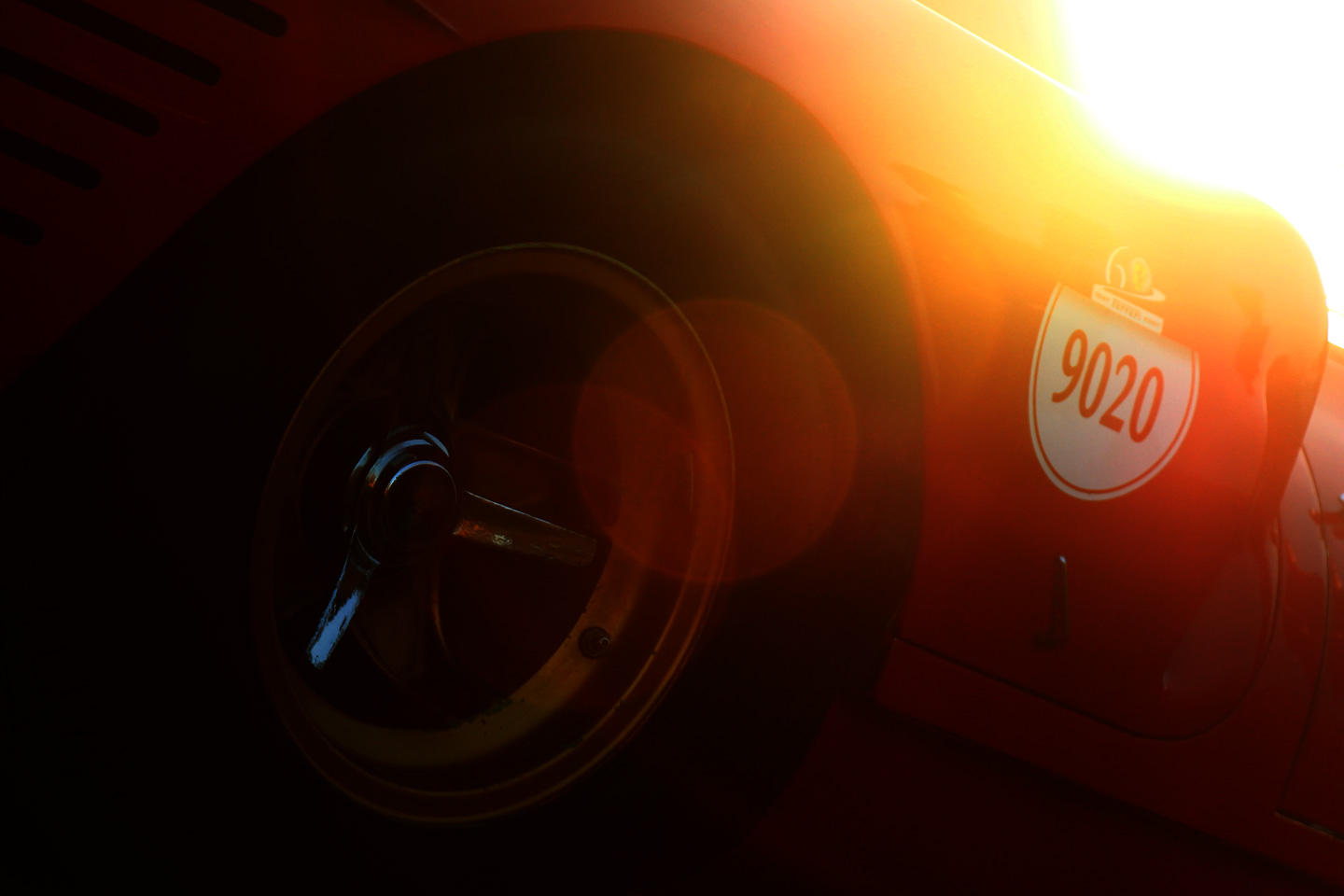Chassis 5685. Metallic Blue, Crema leather. Of the 350 Ferrari 250 GT Berlinetta Lusso built only 20 were delivered in right hand drive and it is belied that out of the 20 cars built only 17 cars survive today.
Chassis 5685 was first delivered to Mrs. Campbell-Golding via Colonel Ronnie Hall’s Maranello Concessionaires in 1964. The car was originally finished in dark metallic blue with blue leather and first registered ‘6 HLA’
Very early in the cars life it 5685 was repainted in a very attractive light metallic green as this was reputed the color of Mrs. Campbell-Golding’s favorite scarf, and the leather was conollised black. Mrs. Campbell-Golding enjoyed her Lusso regularly and after covering approximately 90,000 miles a piston rod went through the side of the block. Mrs. Campbell-Goding immediately brought the car back to Maranello Concessionairs and demanded that the engine was replaced, thus a full rebuild was undertaken using a replacement block number 3069.
The car then spent some time off the road until it was purchased by David Cottingham of DK Engineering whom in turn sold the car to Mr. John Braithwaite. Mr. Braithwaite owned the car for more than 20 years during which time he undertook a full restoration over a 3 year period that was fully documented in the Ferrari Owners Club magazine in 1983 (Volume 15, numbers 2, 3 and 4) as one an example of a near perfect restoration During the restoration the car was painted in British racing Green and the interior retrimmed in cream. Mr. John Braithwaite went on to win to win its class at the Ferrari Owners Club Concourse.
5685 was then sold in 2002 and by this time Lusso’s had become more valuable although Mr. Braithwiat regretted selling his car as he thoroughly as the car remained close to his heart and he had fond memories of the driving experience. The car was then sold at Auction in 2004 in London.
More recently 5685 has undergone a full repaint and is now finished in its original dark shade of Metallic blue and the current vendor has had the car fully serviced by Marque Specialists. Furthermore the current owner has sourced an original Ferrari 250 GT Lusso block that will be supplied to the new buyer with the car should he wish to rebuild a Lusso engine for the car. History file from 1964.
Introduced in the fall of 1962, the 250 GT Berlinetta Lusso was Ferrari’s latest intermediate model, a vehicle to bridge the gap between competition racers and luxuriously appointed 2+2 Coupe’s. In the past, models like the 250 GT Pinin Farina ‘Notchback’ and SWB Lusso had occupied this middle ground, however, Ferrari's new model struck a perfect balance between what were two very different automobiles. It combined exceptional performance and sultry looks and today the GTL is widely regarded as one of Pininfarina's greatest ever designs - no small complement considering some of their exquisite bodywork from the last 60 years.
The Lusso's tubular steel Tipo 539 chassis was eminently comparable to the frame seen on Ferrari's awesome 250 GTO. Sharing an identical wheelbase of 2400mm, primary points of difference were smaller diameter steel tubing and the Lusso's forward mounted engine to increase cabin space. Otherwise, the independent front suspension and live rear axle set up, with hydraulic discs all-round and Borrani wire wheels, was very much the same. Once again, the single overhead camshaft, 60° V12 used in these GTL's was another descendent of Colombo's original unit, Lusso's representing the pinnacle of development for the legendary 250 unit. Designated Tipo 168, the engine was little more than a mildly de-tuned version of Ferrari's racing spec units used in the aforementioned GTO. Displacement remained at the by now familiar 2953cc thanks to a bore and stroke of 73mm x 58.8mm respectively. Output was 250bhp at 7500rpm with a compression of 9.2:1 and three twin choke Weber 36 DCS downdraught carburettors. However, by special request, both thse could be altered according to the desires of any particular client. For example, some Lusso's received high compression units whilst hot 36 DCZ or even 40 DCL and DCZ carburettors were fitted to some motors. Indeed, it's believed that one or two GTL's left Maranello producing a GTO-rivalling 290bhp!
Performance of the standard Berlinetta was itself enough though with a top speed of 150mph and 0-60 time of under seven seconds. All bar a couple of those special order Lusso's were constructed with Ferrari's regular four-speed, all synchromesh gearbox. As had become normal practice by the early sixties, bodywork for the Lusso was designed by the Turin-based carrozzeria of Pininfarina who had by now established a very strong bond with the Maranello manufacturer that still exists today. The actual fabrication of these bodies though was carried out by Scaglietti of Modena, another firm that were enjoying very close links with Ferrari.
Fabricated primarily of steel albeit with lightweight aluminium doors, boot and hood, the Lusso's Berlinetta coachwork made it one of the prettiest series production Ferrari's ever built. Light and aggressive but incredibly stylish, these 250 GT's masterfully juggled the transition from 1950’s elegance to 1960’s curvaceousness. Restrained but never conservative, the Lusso was blessed with some wonderful detailing like the almost rectangular egg crate grille, the crisp wings and the unique chrome bumperettes located beneath each supplementary lighting pod. Combined with a central chrome bumper strip, the Lusso was provided with an unusual three-piece front bumper arrangement that was little more than purely decorative. Its side profile revealed a design uncluttered by vents or unnecessary decoration whilst the cabin, thanks to its slim pillars and wraparound rear windscreen, was very light and airy. A simple Kamm tail facia with single circular light clusters and a small kick up spoiler around the perimeter wrapped up a design that was not only a great contemporary success, but one still regarded as an absolute masterpiece. Meanwhile, the cabin of combined all the components that defined exclusive GT motorcars from the early sixties, Pininfarina fitting heavily bolstered bucket type seats trimmed in the finest leather and also designing a truly unique arrangement for the instruments.
Centrally mounted on the leather-covered dash were a large speedometer and tachometer, both cowled and angled towards the driver with five smaller gauges mounted directly behind the wood rimmed, triple aluminium spoked Nardi steering wheel. A flip-up ashtray was mounted on the sometimes quilted transmission tunnel while plenty of luxurious leather and carpeting lent a genuine sense of refinement to the cockpit. Behind the two seats there was a leather covered luggage area with two retention straps, this space acting more or less as the main stowage location as the boot was normally filled with a spare wheel and toolkit. The fixed seats meant getting luggage in and out was sometimes a little difficult, but such minor indiscretions were easily forgiven. The prototype was shown during October of 1962 at the Paris Salon where it caused a great deal of interest, production models subsequently being ready for delivery by early 1963.
Continuing in production with more or less the same specification until late 1964, Ferrari's 250 GT Berlinetta Lusso was eventually replaced by the firms equally impressive 275 GTB. Some 350 examples had been completed, 23 of which were to right-hand drive configuration. But although nearly all Lusso's were constructed to a generally identical specification when the coachbuilders art of tailoring a bespoke machine to their clients exact requirements was seemingly all but gone, a number of special alterations were made to a handful of GTL's. For example, Ferrari are believed to have fitted a couple of five-speed gearboxes, were quite happy to alter axle ratios and even plumbed air conditioning into one car.
